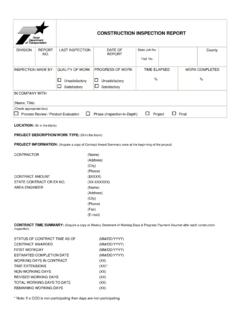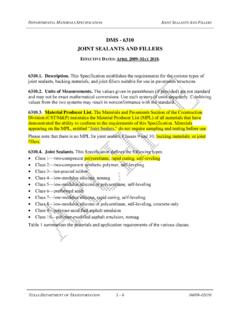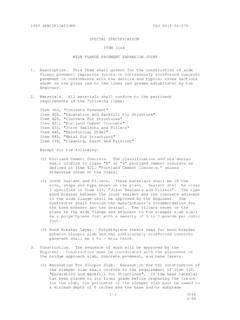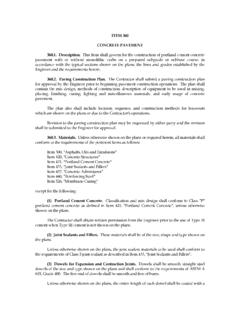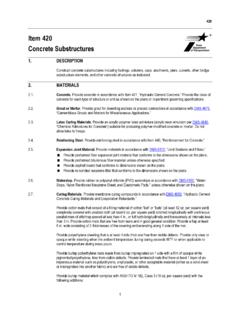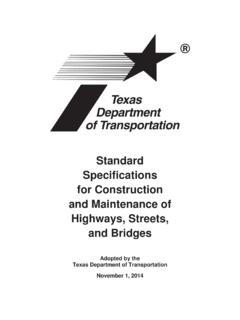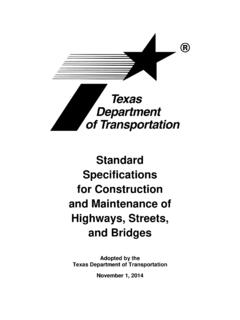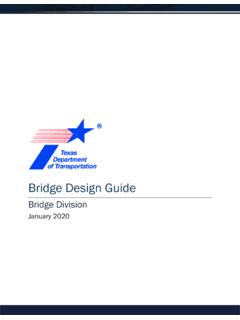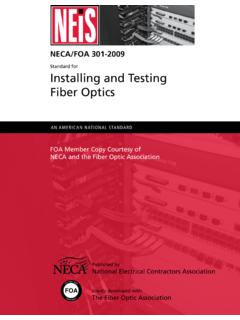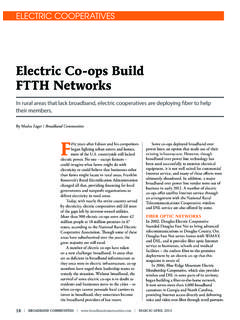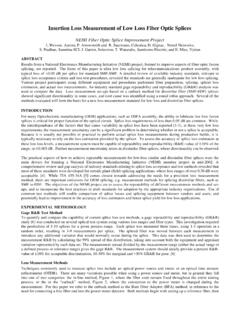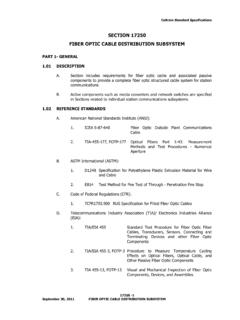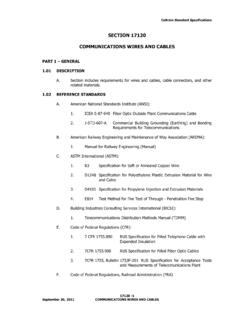Transcription of Special Specification 6007 Intelligent Transportation ...
1 6007 1 - 13 03-16 Statewide Special Specification 6007 Intelligent Transportation System (ITS) fiber optic Cable 1. DESCRIPTION Furnish, install, relocate and remove Intelligent Transportation System (ITS) fiber optic cable, fiber patch panels and splice enclosures as shown on the plans. 2. MATERIALS General Requirements. Provide, assemble, fabricate and install materials that are new, corrosion resistant, and in accordance with the details shown on the plans and in these Specifications. Furnish, install, splice, and test all new fiber optic cable. Provide all splicing kits, fiber optic cable caps, connectors, moisture or water sealants, terminators, splice trays, fiber optic jumpers, pig tails, fiber patch panels, fiber interconnect housing, and accessories necessary to complete the fiber optic network. Provide all equipment necessary for installation, splicing, and testing.
2 Cable Requirements. Furnish all-dielectric, dry-filled, gel-free, loose tube fiber optic cable, with low water peak, suitable for underground conduit environments or aerial applications. Furnish self-supporting, all-dielectric, dry-filled, gel-free, loose tube fiber optic cable, with low water peak suitable for aerial applications when not lashing to strand cable. All fiber optic cable furnished must have a design life of 20 yr. when installed to the manufacturer s specifications. Splice fiber optic cables in ground boxes, field cabinets, or buildings. Terminate fiber optic cables in field cabinets and buildings that comply with the details shown on the plans and in this Specification . Provide all fiber optic cable from the same manufacturer and the manufacturer is International Organization for Standardization (ISO) 9001 certified. Ensure the cables meet or exceed United States Department of Agriculture Rural Utilities Service (RUS) CFR , American National Standards Institute/Insulated Cable Engineers Association (ANSI/ICEA) S-87-640, and Telecommunications Industry Association/Electronic Industries Alliance (TIA/EIA)-492-CAAB standard.
3 Optical Requirements. Optical Fiber. Provide ITU single mode fiber optic cable with a core diameter of microns and a cladding diameter of 125 microns. Provide optical fiber made of glass consisting of a silica core surrounded by concentric silica cladding, free of imperfections and inclusions. Core/Clad Concentricity. Provide an offset between the center of the core and cladding less than microns. Mode Field Diameter. Provide single mode fiber optic cable with the effective area or Mode Field Diameter of the fiber must be m at 1310 nm and m at 1550 nm. Primary Coating. Provide fiber with a coating diameter of 250 15 microns. 6007 2 - 13 03-16 Statewide Attenuation. Provide single mode fiber optic cable with nominal attenuation of dB/km maximum at a wavelength of 1310 nm and nominal attenuation of dB/km maximum at a wavelength of 1550 nm.
4 Attenuation at water peak must be less than dB/km at 1383 nm. Bandwidth and Dispersion. Provide single mode fiber optic cable with a maximum dispersion of: ps/nm-km at a wavelength of 1310 nm, and 18 ps/nm-km at a wavelength of 1550 nm. Zero dispersion wavelength must be between 1300 nm and 1324 nm and the zero dispersion slope at the zero dispersion wavelength must be less than ps/(nm2 km). The cutoff wavelength must be less than 1260 nm for single mode fibers specified to operate at 1310 nm. The cutoff wavelength must be less than 1480 for single mode fibers specified to operate only at 1550 nm or higher. The macrobend attenuation per 100 turns must not exceed dB at 1310 nm and 1550 nm. Mechanical Requirements(Tensile Strength). Provide a cable withstanding a pulling tension of 600 lbf without increasing attenuation by more than dB/mi when installing in underground conduit systems in accordance with EIA-455-33A.
5 Conduct an impact test in accordance with TIA/EIA-455-25C (FOTP-25) and a compression load test in accordance with TIA/EIA-455-41A (FOTP-41). For all-dielectric self-supporting cable (ADSS) and other self-supporting cables, meet tensile strength requirements in accordance with Section 25, Loading of Grades B and C, of National Electric Safety Code (NESC), for the maximum span and sag information as shown in the plans for aerial construction. Bend Radius. Provide a cable withstanding a minimum bending radius of 10 times its outer diameter during operation, and 20 times its outer diameter during installation, removal and reinstallation without changing optical fiber characteristics. Test the cable in accordance with EIA-455-33A. Buffering. Use a buffering tube or jacket with an outer diameter of to mm containing 12 individual fiber strands.
6 The fibers must not adhere to the inside of the buffer tube. Color Coding. Provide fiber and buffer tubes with a color coating applied to it by the manufacturer. Coating must not affect the optical characteristics of the fiber. Provide color configuration in accordance with TIA/EIA-598 as follows: 1. Blue 2. Orange 3. Green 4. Brown 5. Slate 6. White 7. Red 8. Black 9. Yellow 10. Violet 11. Rose 12. Aqua 3. EQUIPMENT Cable Type. Provide cables with a reverse oscillation or planetary stranding structure. Jacket construction and group configuration should separate at splice points to cut and splice 1 set of fibers while the others remain continuous. All cable jackets must have a ripcord to aid in the removal of the outer jacket. Submit cable designs for approval. Strand loose buffer tubes around a dielectric central anti-buckling strength member.
7 Provide dielectric aramid or fiber glass strength members with specified strength for the cable. Provide cable with a water-blocking material, which is non-hygroscopic, non-nutritive to fungus, non-conductive, non-toxic, and homogeneous. The water blocking material must comply with TIA/EIA-455-81B and 455-82B as well as TIA/EIA-455-98. 6007 3 - 13 03-16 Statewide Ensure a polyethylene inner jacket is applied over the cable core, and that the entire cable is enclosed with a polyethylene outer jacket. Ensure the outer jacket contains black carbon to provide UV protection for the cable. Ensure each cable is marked with the manufacturer s name, the date of manufacture (month/year), the fiber count (example 48F SM), and sequential length markings at maximum 2 ft. increments, measured in units. For aerial installation, provide standard fiber optic cable lashed to steel messenger cable or ADSS in accordance with the Institute of Electrical and Electronics Engineers (IEEE) 1222 Standard for Testing and Performance for All-Dielectric Self-Supporting (ADSS) fiber optic Cable for Use on Electric Utility Power Lines, or most current version.
8 Provide ADSS cable in accordance with the maximum span distance, weather load rating, and allowable sag as shown on the plans. Figure 8 self-supporting cable with integrated messenger cable within the outer jacket for aerial installation is acceptable. Cable Size. Furnish cables with a maximum diameter not exceeding 19 mm. Environmental Requirements. Provide cable that functions in a temperature range from -40 F to 158 F. fiber optic Accessories. Splice Enclosures. Furnish and install 1 of 3 types of underground splice enclosures at locations shown on the plans to accommodate the cables being spliced at that point. The types are as follows: Type 1: 4 cable entry ports total 2 ports to accommodate backbone fiber of up to 144 fibers and 2 ports for drop cables of up to 48 fibers, Type 2: 6 cable entry ports total 4 to accommodate backbone or arterial cables of up to 144 fibers and 2 ports for drop cables of up to 48 fibers, and Type 3: 8 cable entry ports total 4 to accommodate backbone or arterial cables of up to 144 fibers and 4 ports for drop cables of up to 48 fibers.
9 Provide the end cap of the canister splice closure with re-enterable quick-seal cable entry ports to accommodate additional branch cables or backbone cables. Provide fiber optic splice enclosures with strain relief, splice organizers, and splice trays from the same manufacturer as the splice enclosure. Select the appropriate splice enclosure type based on the number of splices called for in the plans. Suspend all splice closures off floor of the ground box and secure to cable rack assembly on side wall of ground box. For end of reel splicing, use a fiber optic splice enclosure sized to accommodate full cable splice in one enclosure. fiber optic splice enclosure must be of the same manufacturer as other supplied on a project. Splice enclosure and fusion splicing required for end of reel will be incidental to the fiber optic cable. Comply with the Telcordia Technologies GR-711-CORE standard and all applicable NEC requirements.
10 Contain all optical fiber splices within a splice enclosure, providing storage for fiber splices, nonspliced fiber, and buffer tubes. Provide sufficient space inside the enclosure to prevent microbending of buffer tubes when coiled. Ensure that the splice enclosure maintains the mechanical and environmental integrity of the fiber optic cable, encases the sheath opening in the cable, and organizes and stores optical fiber. Ensure all hinges and latching devices are stainless steel or of a non-corrosive material designed for harsh environments. Ensure that the enclosure is airtight and prevents water intrusion. Ensure that splice enclosures allow re-entry and are hermetically sealed to protect internal components from environmental hazards and foreign material such as moisture, dust, insects, and UV light. Field Rack Mount Splice Enclosures. Provide a 19 in.

